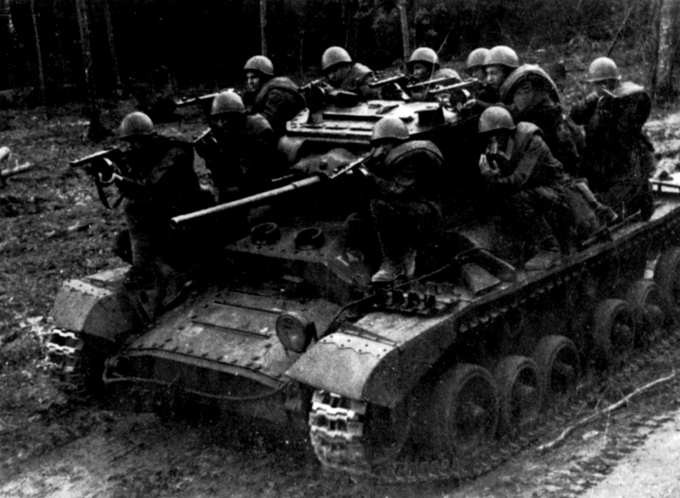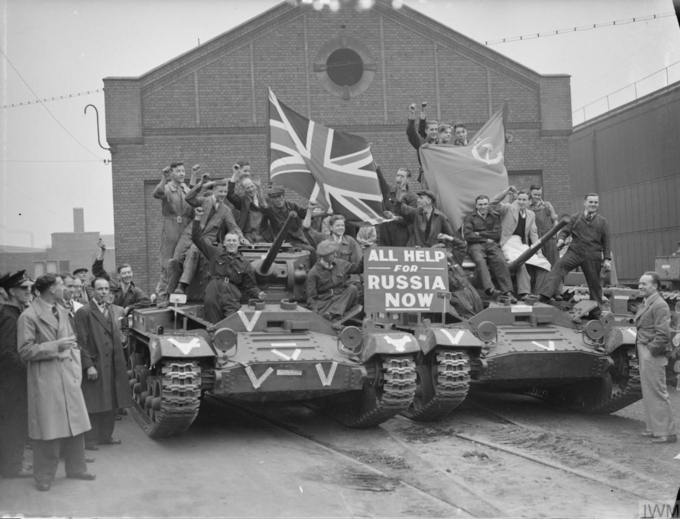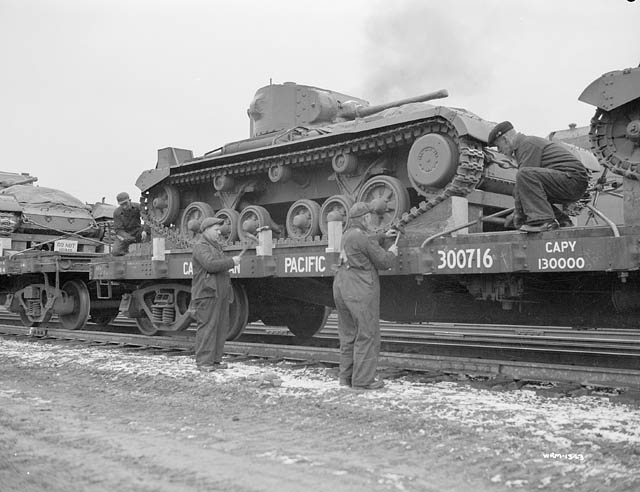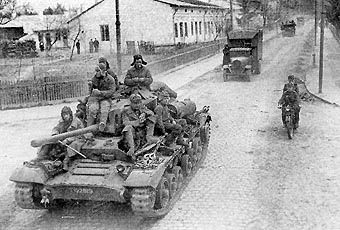Among the different tanks provided to the Soviet Union as part of the Lend-Lease program, arguably the most underrated tank was the Valentine tank. An infantry tank that the British eventually phased out for newer tanks like the Churchill, the Valentine had a surprising staying power within the Soviet Army. The Soviet Army received half of all Valentines produced by the British and Canadians and used them all the way to the end of the war against both the Germans and Japanese.
Lend-Lease to the Soviet Union
As part of the Lend-Lease program, the Soviet Union requested tanks and other military supplies from America and Great Britain to replenish their losses during their defense against Nazi Germany. Evaluating the available tank models that could be sent to the Soviet Union, the Soviet liaison mission in Britain decided on two tanks, the Matilda and the Valentine tank. The shipments of Valentine tanks would be fulfilled by the Birmingham Railway Carriage and Wagon Company, which began on September 28, 1941.
The first British tanks sent in the Lend-Lease shipment, carrying 20 Valentine tanks, arrived in the Soviet Union on October 11, 1941, at the port of Arkhangelsky as part of the Arctic convoys. A training program for the Valentines was created at the Kazan Courses of Armoured Force Improvement (KUKS) by October 15th, while the tanks arrived at the location on October 28th. Alongside the second tank shipment of 120 Valentine tanks were 22 British men who helped the Soviets organize repair workshops and other knowledge transfers about the tanks, which concluded on November 11th. Training was expedited to a 15-day course, but 120 crew members were trained by mid-November. By the end of 1941, 259 Valentine tanks had been sent to the Soviet Union, with 216 issued to combat formations.
The Valentines first saw use in late November 1941 among the 136th, 137th, 138th, and 139th Independent Tank Battalions with a total of 97 Valentines, mostly in the defense of Moscow around what was considered second-rate enemies. In Soviet nomenclature, the Valentines were referred to as "English tank MK-III*." Problems with the Valentine design became apparent, especially in cold weather where the ventilation system design made the interiors too cold, a cooling system that overcooled the engine, and tracks that lost traction in deep snow. Another complaint was the Valentine II's armament, the 2-pdr gun, for its lack of high-explosive shell availability. The Soviets attempted to remedy the issue by replacing the 2-pdr gun with a 45 mm 20-K gun at the Grabin design bureau at Factory #92. While the redesign proved feasible, the shortage of 45 mm guns and lack of significant improvements in anti-tank performance led to the project's cancellation in January 1942. Overall, while the Soviets have criticism of the Valentine tank's design, they judged the performance to be more useful than the Matilda, even in the winter, and equivalent or better to their domestic light tanks, with Soviets classifying the Valentines as light tanks during the Battle of Moscow. Due to this, on December 03, 1941, Stalin requested the British Minister of Supply, Lord Beaverbrook, to prioritize the shipment of Valentine tanks over the Matilda tanks.
Canadian Production
Due to the positive reception of the Valentine tanks, the British decided that Canada would fulfill future Valentine tank deliveries to the Soviet Union. With the Canadian Pacific Railway Company originally ordered to produce 300 Valentine tanks for the British and 488 for the Canadian army in June 1940, the British order was increased to 1,420 tanks in October 1941, with 30 of those tanks being Valentine VI slated for the Canadian army. Canadian tank industry, producing their first tank on 22 May 1941, began their deliveries of Valentine VII tanks to the Soviet Union in November 1941, but their first shipments would not arrive until 1942. Deliveries continued until May 1943 upon completion of the Canadian orders, with 1,388 (2 were retained for British trial purposes) sent to the Soviet Union, and 1,208 arriving in the Soviet Union ports.
Valentine with 6-pdr for the Soviet Union
By late 1942, Vickers had upgraded the Valentine to the Mark IX variant with a 6-pdr gun. The Soviets discovered the tank type in late December 1942. The Soviets received the first 6-pdr-equipped Valentine in February 1943.
Evaluations were carried out to determine if the Soviets should order more. Soviets praised the improved penetration power of the 6-pdr, but there was still a lack of high-explosive shell production for the 6-pounder gun. The new turret used to equip the 6-pdr removed the coaxial machine gun and replaced the turret bomb thrower with external launchers, both changes that the Soviets were not enthusiastic about. These characteristics led the Soviets to consider the Valentine IX more as a tank destroyer than a tank, and as such, issued the Valentine IX out in heterogeneous formations alongside older 2-pdr equipped Valentines that had better characteristics to fight infantry. The Valentine Mk IX issues would be addressed by American supplies and British development. The Americans, producing their own version of the 6-pounder as the 57 mm M1 gun, were also concerned about the lack of available HE shells and began to produce their own, supplying it to the Soviets for their Valentines alongside the 57 mm M1 equipped T48 GMC (which the Soviets would use as the SU-57). While the lack of a coaxial machine gun was initially resolved with the installment of a BREN machine gun on an anti-aircraft pintle-mount, the coaxial machine gun mount would be reintroduced in the Valentine X variant with a new turret design, which would begin arriving in 1944. These resolutions, even just equipping the Valentines with high-explosive shells, allowed the Soviets to issue the 6-pdr equipped Valentines in homogenous formations without 2-pdr Valentines.
Despite the initial flaws, the Soviets accepted the 6-pdr equipped Valentines and continued to request them in their Lend-Lease shipments. With Canada's production order finished, the British continued to produce Valentines in 1943 for Soviet Union deliveries, though the British were perplexed that the Soviet Union had continued interest in a tank that they had already considered obsolete. 910 Valentine IX and X would be sent between 1943 and 1944, with 884 received by the Soviet Union. The number of Valentine tanks in Soviet inventory, as well as their overall positive combat performance, led to the Soviet Union deciding to end their light tank production and have the Valentines continue to fulfill their light tank role, with the light tank factories committing to SU-76 production.
The Valentine tanks of all variants would continue to be used in the Red Army in locations such as Ukraine, Czechoslovakia, and Germany until the end of the war in Europe. The Valentines would also continue to be used in the Soviet's operation in Manchuria against the Japanese, with up to 81 Valentine tanks present alongside Valentine bridge layer companies.
Total Lend-Lease Numbers
Of the 7,260 Valentine tank models that would be produced by Britain and Canada (5,840 British, 1,420 Canada), 3,665 of the Valentine tanks would be shipped to the Soviet Union, alongside 25 Valentine bridge layer variants for a total of 3,690. The British and Canadian shipped a large variety of Valentine tank models towards the Soviet Union, With Britain encompassing Valentine II, III, IV, V, IX and X while Canada provided the Valentine VII. Of the 3,665 turreted tanks sent to the Soviet Union (Mk II: 161, Mk III: 346, Mk IV: 520, Mk V: 340, Mk VII: 1,388, Mk IX: 836, Mk X: 74), 415 would be lost at sea during the transit, and so the Soviets received a total of 3,250 Valentine tanks at their ports (Mk II: 136, Mk III: 346, Mk IV: 449, Mk V: 227, Mk VII: 1,208, Mk IX: 818, Mk X: 66).
Bibliography
- Axe, David. 2020. "To Russia With Love: The British Valentine tank in the Red Army." Medium. Last modified March 20, 2020. Website (Archive)
- live M. 2001. Making Tracks: Tank Production in Canada. Ottawa, Ontario: Service Publications.
- Newsome, Bruce Oliver. 2016. Valentine Infantry Tank 1938-45. Great Britain: Osprey Publishing. Kindle.
- Pasholok, Yuri. 2016. "Valentine Mods in the USSR." Tank Archives. Translated by Peter Samsonov. Last modified March 13, 2016. Website (Archive)
- Pasholok, Yuri. 2017. "British Tank for Soviet Infantry." Tank Archives. Translated by Peter Samsonov. Last modified November 04, 2017. Website (Archive)
- Pasholok, Yuri. 2019. "Valentine With a Long Gun." Tank Archives. Translated by Peter Samsonov. Last modified January 26, 2019. Website (Archive)
- Zaloga, Steven J. 2017. Soviet Lend-Lease Tanks of World War II. Great Britain: Osprey Publishing. Kindle.




